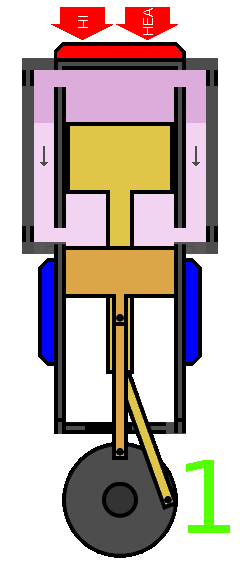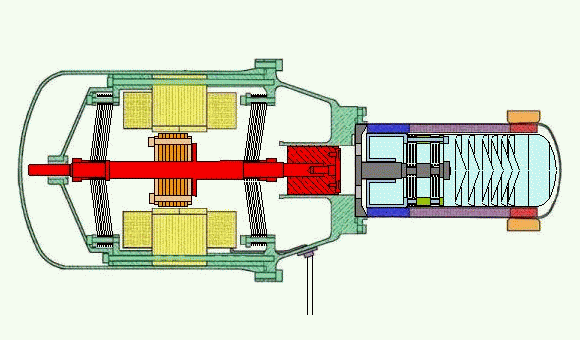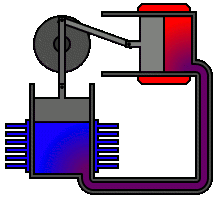
Useful Animations
Share
To Help You Understand Stirling Engines
It can be difficult to understand how Stirling engines work because they are very different than gasoline and diesel engines.
Hopefully, these animations will make understanding Stirling engines easier.
Which Animations are Included Here?
The animations I have included in this list are, in my opinion, the most important configurations of Stirling engines, but there are many other possible configurations.
Rhombic Drive Stirling Engine
I have a long-standing love affair with smooth running machines. That’s why I like the Rhombic drive Stirling engine configuration.
This configuration can be 100% mass-balanced.
That doesn’t mean if you build one it will be balanced perfectly on the first run, but it can be balanced perfectly if you build it carefully and that’s important.
Rhombic Stirling Engines Can be Pressurized
I also like the rhombic configuration because it’s relatively easy to pressurize. That’s important for getting more power out of a Stirling engine of any given size and weight.
It’s important to note that the working gas part of a rhombic and a beta Stirling engine are identical. The difference is in the drive mechanism.
All Rhombic Engines are also Betas
All rhombic drive Stirling engines are beta configurations, but some beta configuration engines use other drive mechanisms.
These animations show a slightly different regenerator setup, but that is not an important difference.
Look at the piston in the animation above and the animation below carefully for a minute. You will note that the relative piston motion is identical, despite the fact that the mechanisms that produce that motion are very different.
Beta Type Stirling Engine

This is an animation of a beta type Stirling engine where you put everything in one cylinder. The heating and cooling is continuous, not pulsed as you might think from this animation.
The beta configuration of a Stirling engine was commonly used in antique water pumping engines and engines for domestic use.
It’s a perfectly good configuration for heavy and slow turning cast iron engines, but it doesn’t work well if you try to make an engine that runs much faster.
Heating and Cooling are Continuous
From looking at this animation above, you might think that the heat at the top (the red arrows pointing down) and the cooling at the bottom (the red and blue arrows pointing to the left) are intermittent, like the firing of an internal combustion engine.
But that’s just a feature of this animation. Real Stirling engines are continuously heated on the hot end and continuously cooled on the cold end.
Low-Temperature Difference Stirling Engine
Low-temperature difference Stirling engines (LTD Stirling engines if you like acronyms) are technically gamma configurations, but they are so different than high-temperature difference Stirling engines, that they deserve a category of their own.
These engines are typically designed to run on temperature differences of less than 100 degrees C and they have a displacer cylinder that is relatively very wide and short.
American Stirling makes a range of low-temperature difference stirling engines models with the same basic configuration as the animation above.
Uses of Low-Temperature Difference Stirling Engines
Low-temperature difference engines are mostly used in education and as toys.
This is because it’s hard to get a significant amout of power out of the given size engine when you are using this configuration.
Yes, the world is full of free low-temperature heat sources, but the engines needed to extract power from that heat tend to be big for the amount of power they put out.
Gamma Stirling Engine

This is a gamma type Stirling engine animation. This configuration is popular in models and in antique water pumping engines.
Gamma Stirling engines were popular in antique engines for home use and for pumping water.
They remain a popular configuration for models.
The animation above shows the difference between a piston and a displacer especially well. The blue piston is tight and the working gas (often air) pushes up and down on this piston.
The green displacer above has a clearance fit and the working gas flows around it. The gas does not push on the displacer.
Engines like this hill have a regeneration effect even if the engine does not have a specifically-designed re-generator.
Two-Piston Gamma Stirling Engine
Rember that I told you that there were many different configurations of Stirling engines?
Well, the gamma animation immediately above is essentially the same thing as the mostly orange and yellow gamma Stirling engine animation displayed before that, but with a different mechanism for making it work.
Free Piston Stirling Engine

This is a public domain free piston Stirling engine animation from NASA. Please right click on it and save it to your computer and feel free to use it anywhere. The engine part is on the right and the linear alternator is on the left.
I absolutely love free-piston Stirling engines and here’s why:
Imagine you could figure out a way to take all the complexity of a rhombic drive engine, and all the balancing troubles of a beta engine and simply get rid of it?
What if you could design a Stirling engine that was easy to pressurize and all you had to do (once you worked out the details) was put in natural gas on one end and take electricity out the other end?
Wouldn’t that be cool?
William Beale – Sunpower Invention
In 1964, William Beale a professor of mechanical engineering at Ohio Universtiy in Athens, Ohio did just that.
It was an invention that should have changed the world, but didn’t.
Sunpower got lots of government research money, all the prototypes worked, and all the intellectual property was perfected, but nothing was ever released to the public.
There’s a Good Book about Free Piston Stirling Engines
A well-written book was published about the Sunpower Free-Piston Stirling engine story called, “The Next Great Thing.” Unfortunately, they never published a book about how to design free-piston Stirling engines.
And how to design them wasn’t obvious! William Beale knew, and a few engineers at Sunpower knew, but the knowledge of how to design this class of Stirling engine never became widespread.
Perhaps You Will Write a Design Book
The original patents have long since expired, so hopefully, someone will look them up and write a design guide.
Maybe you will be the one, who knows! There is no “they” who does these kinds of things. It’s only you, and me, and the other guy.
Alpha Stirling Engine

This is an alpha configuration Stirling engine. Note the two pistons and the 90 degree V. Red is hot, blue is cold
The alpha configuration Stirling engine is not my favorite because it’s mechanically complex and runs the working gas down a long pipe.
The positive thing about this type of design is that it’s easy to separate the hot parts from the cold parts. Stirling coolers and some power producing engines use this configuration.
Popular With Home Shop Machinists
A lot of people who try to convert other machines, like air conditioning compressors to Stirling engines end up with an alpha configuration.
Some of the commercially-made Stirling engines use this configuration, so it can be made to work, but it’s very easy to have the gas velocities inside the transfer tube approach the speed of sound and have the internal aerodynamic losses be high.
If this happens, the internal friction will become very high and the shaft power output will be lower than hoped for.
This configuration of Stirling engine especially requires you to think like an aerodynamicist when designing a supersonic airplane. Be aware of the Mach numbers of the working gas.


